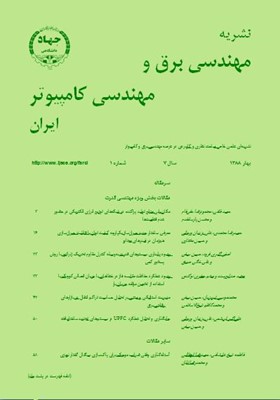جایگذاری و تحلیل عملکرد UPFC در سيستمهاي تجدید ساختار یافته
محورهای موضوعی : electrical and computer engineeringعلیاکبر ابریشمی 1 , علی یزدیان ورجانی 2 , حسین سیفی 3
1 - دانشگاه تربیت مدرس
2 - دانشگاه تربیت مدرس
3 - دانشگاه تربیت مدرس
کلید واژه: پخش بار بهینهتجزیه مربعیضرایب LMPکنترلکننده یکپارچه توان,
چکیده مقاله :
در این مقاله مدل جدیدی برای کنترلکننده یکپارچه توان (UPFC) در حالت ماندگار ارائه شده است. با استفاده از این مدل، عوامل مؤثر در تغییر تابع هدف بازار برق، ناشی از اضافهشدن UPFC به شبکه، به چهار مؤلفه شامل افزایش امپدانس سری خط، جبرانسازی توان راکتیو موازی، مؤلفه همفاز ولتاژ سری و مؤلفه قائم ولتاژ سری تجزیه شده است. در مطالعات عددی با جایگذاری UPFC در نقاط مختلف شبکه آزمون تأثیر هر مؤلفه در تغییر تابع هدف بازار برق با شبیهسازی اندازهگیری شده و با نتایج حاصل از روش تحلیلی مقایسه شده است. همچنین هزینه تأمین مگاوات و مگاوار بعدی (ضرایب LMP) با استفاده از پخش بار بهینه محاسبه شده و ارتباط تنظیمات بخش سری UPFC با این ضرایب مورد مطالعه قرار گرفته است.
In this paper a new steady state modeling of unified power flow controller (UPFC) is proposed. Using this model, factors that affect the objective function of electricity market as a result of UPFC installation in power grid has been decomposed into four components, including line series impedance increase, shunt reactive power compensation, in-phase component of series voltage and quadrature component of series voltage. An UPFC has been placed in different points of a test system and impact of each component on objective function of electricity market has been measured by simulation and compared with results from analytical method. Both active and reactive locational marginal prices are calculated and their relation with settings of UPFC series part has been studied.
[1]X. P. Zhang and E. J. Handschin, "Advanced implementation of UPFC in a nonlinear interior -point OPF," Gen., Trans. and Dist.,IEE Proc., vol. 148, no. 5, pp. 489-496, Sep. 2001.
[2]K. S. Verma, S. N. Singh, and H. O. Gupta, "Optimal location of UPFC for congestion management," Elect. Power Syst. Res., vol. 58,no. 2, pp. 89-96, Jul. 2001.
[3]B. Venkatesh, M. K. George, and H. B. Gooi, "Fuzzy OPF incorporating UPFC,"Gen., Trans. and Dist., IEE Proc., vol. 151,no. 5, pp. 625-629, Sep. 2004.
[4]S. Y. Ge and T. S. Chung, "Optimal active power flow incorporating power flow control needs in flexible AC transmission systems,"IEEE Trans. Power Syst., vol. 14, no. 2, pp. 738-744, May 1999.
[5]K. S. Verma and H. O. Gupta, "Impact on real and reactive power pricing in open power market using unified power flow controller,"IEEE Trans. Power Syst., vol. 21, no. 1, pp. 365-371, Feb. 2006.
[6]A. J. Wood and B. F. Wollenberg,Power Generation, Operation,and Control , 2nd ed., New York: John Wiley & Sons, 1996.
[7]D. Kirschen and G. Strbac, Fundamentals of Power System Economics , 1st ed., UK West Sussex: John Wiley & Sons, 2004.
[8]T. Johns, A. T. Gazarian and D. F. Warne, Flexible AC Transmission Systems (FACTS), 1st ed., London: IEE Publication, 1999.
[9]H. Ambriz-Perez, E. Acha, C. R. Fuerte-Esquivel, and A. De laTorre, "Incorporation of a UPFC model in an optimal power flowusing Newton's method,"Gen., Trans. and Dist., IEE Proc., vol. 145,no. 3, pp. 336-344, May 1998.
[10]R. Palma, L. S. Vargas, J. R. Perez, J. D. Nunez, and R. A. Torres,"OPF with SVC and UPFC modeling for longitudinal systems,"IEEE Trans. Power Syst., vol. 19, no. 4, pp. 1742-1753, Feb. 2004.
[11]A. G. Bakirtzis, P. N. Biskas, C. E. Zoumas, and V. Petridis,"Optimal power flow by enhanced genetic algorithm,"IEEE Trans.Power Syst., vol. 17, no. 2, pp. 229-236, May 2002.
[12]C. R. Fuerte-Esquivel, E. Acha, and H. Ambriz -Perez, "Acomprehensive Newton-Raphson UPFC model for the quadraticpower flow solution of practical power networks,"IEEE Trans.Power Syst., vol. 15, no. 1, pp. 102-109, Feb. 2000.
[13]Renz, "AEP's Inez project demonstrates unified power flow control,"IEEE Power Eng. Review, vol. 16, no. 11, 6 pages, Nov. 1996.


